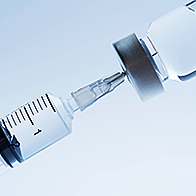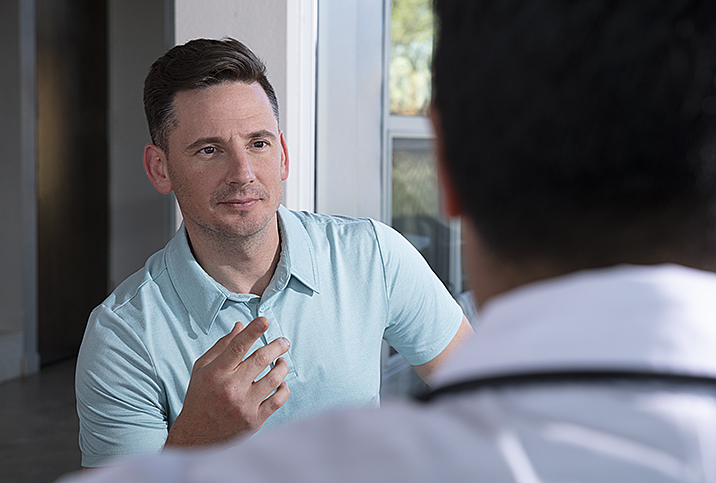Guys, Let's Boost Your Human Papillomavirus Knowledge Base

There's a gender gap to be bridged in knowledge surrounding human papillomavirus (HPV), according to Brynna Connor, M.D., an Austin, Texas-based physician who is the healthcare ambassador at NorthWestPharmacy.com. She explained the role of the healthcare system in this void in male sexual education.
"In my experience, men have no clue about HPV's symptoms and causes. No offense, guys," she said. "Men are not screened the way that cis-biological-females have been. Because of this, they have never had to get up to speed on HPV and the fact that they can contract HPV or contribute [to] HPV's spread."
Hypervigilance is typically encouraged for female sexual health—consider the surplus of female contraceptives compared to male versions. But the institution of medical care for males doesn't always support men's proactivity and accountability for this specific virus.
Fred Wyand, director of communications for the American Sexual Health Association, manages the organization's HPV and cervical cancer prevention programs.
"In general, it's estimated that 75 percent to 80 percent of all sexually active people have a sexually transmitted HPV infection at some point, regardless of gender," he said. "It is the human papillomavirus, of course, and impacts people regardless of gender. Some studies indicate HPV infections in females tend to peak early in their 20s, while with males, it's a bit more evenly distributed across the life span."
This even distribution of infection among all ages intensifies the need for male responsibility in pursuing HPV screening, especially in older men. An older heterosexual man's partner is the woman for whom HPV is most likely to become malignant.
How is HPV spread?
Most cases of HPV resolve naturally, which is partly why the virus is underdetected. HPV's subtleties facilitate invisibility, especially when a patient has no education on what to look for in the way of signs or symptoms, Connor said.
"Often, both men and women show no symptoms of HPV, but this is especially [true] with men," she said. "They will often literally have none. HPV can present as genital warts, and these can sometimes look like a small skin tag or may look like a new lesion that is sometimes dismissed as a mole in men—the same goes for women, for that matter."
Understanding the body's vulnerability to the virus is imperative to understanding your personal role in its spread. While vaginal-to-oral transfer is the most infamous means for men to contract HPV, the virus can be spread by and to all orifices.
Connor said HPV's efficacy is unpredictable, but the virus is undoubtedly highly contagious.
"Any and all orifices—penis, mouth/tongue, anus—are vulnerable to HPV for men," she said, citing World Health Organization (WHO) statistics showing the global prevalence of HPV types is 18.7 percent at the penis, 13.1 percent at the scrotum and 7.9 percent at the perineal region, the area between the anus and scrotum.
"HPV is just as strong when it is passed from one person to another," Connor continued. "It is thought that the efficacy of HPV transmission, or how successfully it gets passed from one person to another, is anywhere from 5 to 100 percent, which is a very wide range, of course, but that is in part because this is difficult to track since people with HPV can be asymptomatic."
HPV cases can be minor or major
Despite the easy-to-miss nature of human papillomavirus, Wyand said the potential outcomes can vary widely, from a naturally resolving case to a precancerous condition.
"Some types of HPV are 'low-risk' types that aren't strongly associated with cancer but can cause anal and genital warts," he said. "Other, 'high-risk' types can, in some cases, lead to a number of types of cancer, including those of the cervix, vagina, vulva, anus, penis, and some head and neck tumors. Most cases of HPV are harmless, don't result in obvious symptoms, are never diagnosed clinically and clear naturally."
This variability is both the lynchpin to male ignorance about HPV and the silver lining. Connor, however, focuses on the more sobering possible outcomes of HPV.
"Oral cancer due to HPV has gained attention in recent years and is a potential risk," she said. "HPV is also the leading cause of oropharyngeal cancers, especially cancer of the tonsils, tonsillar 'crypts' [folds of the tonsils], the base of the tongue and, for a very small number, in the front of the mouth."
Vaccination for HPV
One HPV vaccine, Gardasil 9, has been licensed and approved by the Food and Drug Administration for use in the United States. HPV vaccination prevents new infections but does not treat existing HPV infections or diseases.
The HPV vaccine has both strengths and limitations, Connor said. It helps protect against anal cancer, genital warts and precancerous lesions, but a patient with a history of immediate hypersensitivity to any component of the vaccine needs to discuss that with their physician. Doctors should be wary if the patient has had a severe allergic reaction to yeast or any of the HPV vaccine's ingredients; has had an HIV infection or cancer; uses medicines that affect the immune system; or has a fever above 100.4 degrees Fahrenheit, she said.
While the Gardasil shot brings the possibility of side effects with varying degrees of intensity, any temporary discomfort doesn't compare to the anguish of giving a sexual partner a potentially serious case of human papillomavirus. There's no way of knowing how your own HPV, no matter how long you've had it or how seriously it has impacted your life, will react with someone else's system.
There's no way of knowing how your own HPV will react with someone else's system.
Unfortunately, there is no approved test to determine someone's HPV status or to find HPV in the mouth or throat, according to the Centers for Disease Control and Prevention (CDC). HPV tests can screen for cervical cancer in women (recommended for women age 30 or older), but the CDC does not recommend routine screening for HPV in men.
Some people discover they have HPV when they get genital warts. A doctor may apply a vinegar solution to highlight any warts that aren't visible. Men can also request an anal Pap test, which involves inserting a swab into the anus. However, this test is generally used as a screening tool for men at high risk of anal cancer—it doesn't diagnose HPV directly.
In addition to getting vaccinated for HPV, the next step in bettering your own sexual accountability is to become educated about the virus. If you don't want to get vaccinated for your own health, do it for others.




















